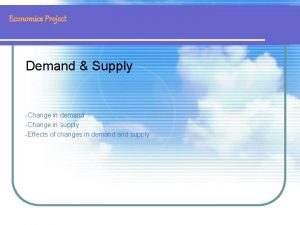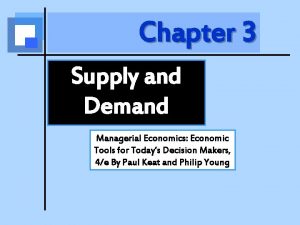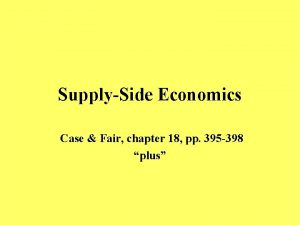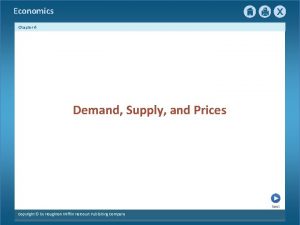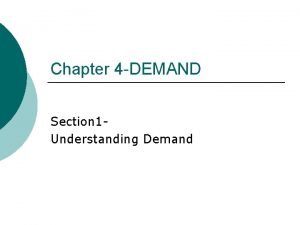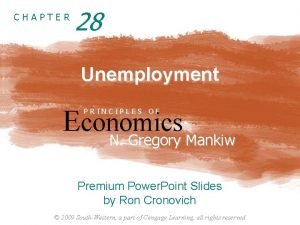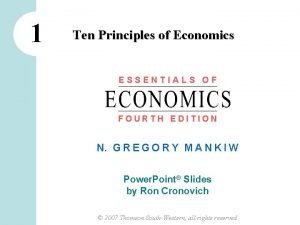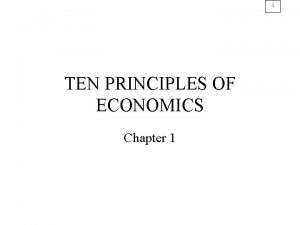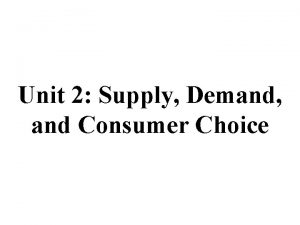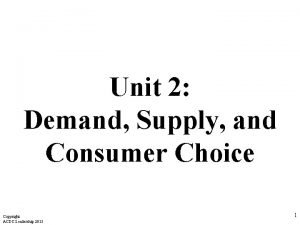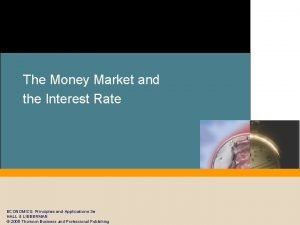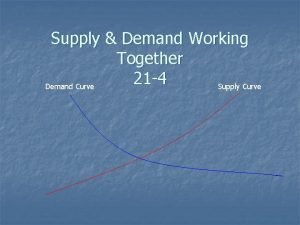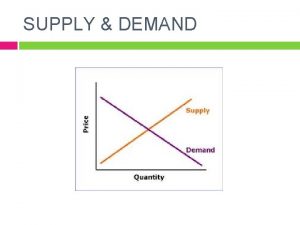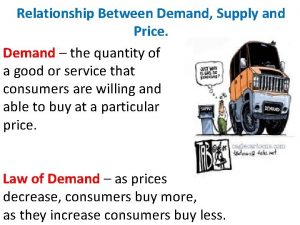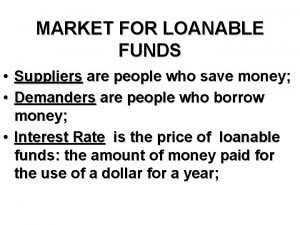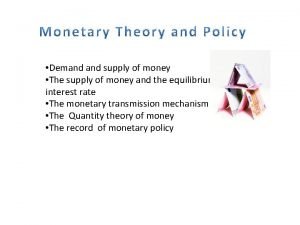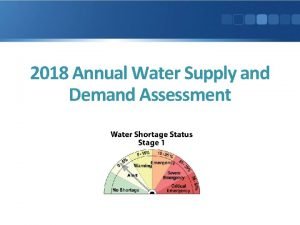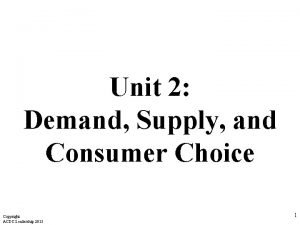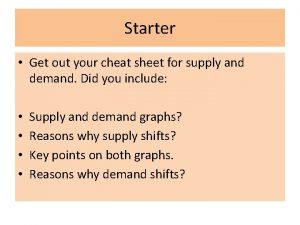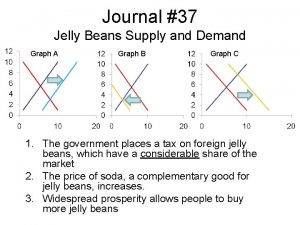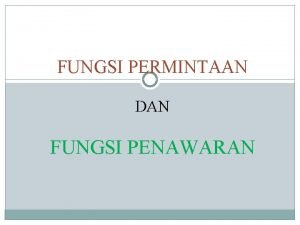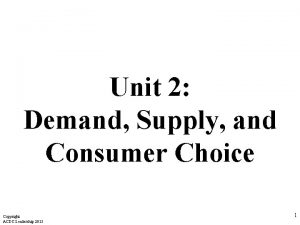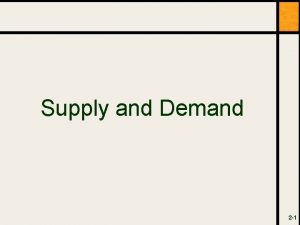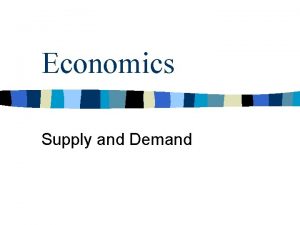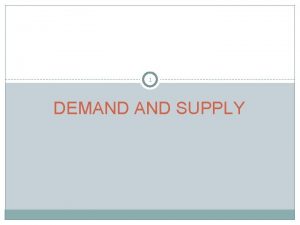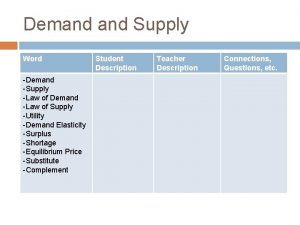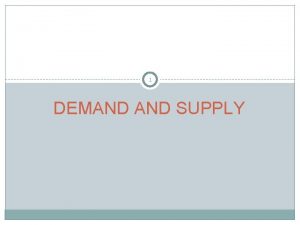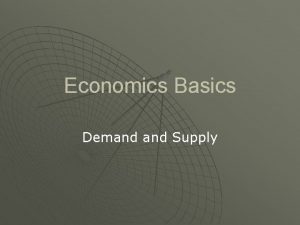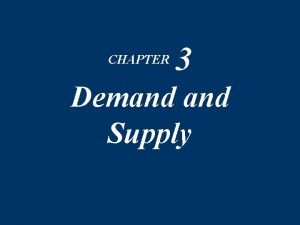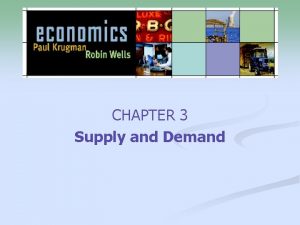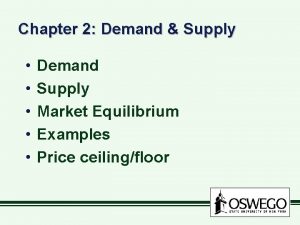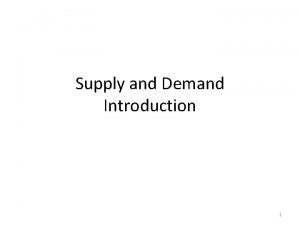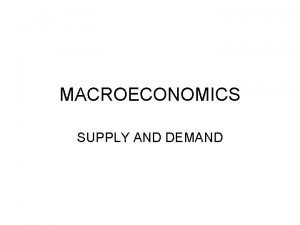Principles of Economics Supply and Demand Chapter 3




















































- Slides: 52

Principles of Economics Supply and Demand Chapter 3 ©Mc. Graw-Hill Education. All rights reserved.

Learning Objectives 1. Describe how the demand supply curves summarize the behavior of buyers and sellers in the marketplace. 2. Discuss how the supply and demand curves interact to determine equilibrium price and quantity. 3. Illustrate how shifts in supply and demand curves cause prices and quantities to change 4. Explain and apply the Efficiency Principle and the Equilibrium Principle (also called the “No-Cashon-the-Table Principle”). ©Mc. Graw-Hill Education. All rights reserved. 3 -2

Supply and Demand: An Introduction • How do consumers get the goods and services they want in the right quantities and qualities? – Some goods and services are allocated by the market forces of supply and demand • Why do some goods and services have shortages or surpluses and others do not? – Some goods and supplies services are regulated by government Chapter 3 - Supply and Demand: An Introduction 3 -3

What, How, and For Whom? • Every society answers three basic questions WHAT § Which goods will be produced? § How much of each? HOW § Which technology? § Which resources are used? FOR § How are outputs distributed? § Need? WHOM § Income? ©Mc. Graw-Hill Education. All rights reserved. 3 -4

What, How, and for Whom? Central Planning Versus the Market • Centralized Economic Organizations – Agrarian society – Former Soviet Union – Cuba, North Korea – China (under Mao) – Bureaucracy Chapter 3 - Supply and Demand: An Introduction 3 -5

Central Planning versus the Market Central Planning • Decisions by individuals or small groups • Agrarian societies • Government programs – Sets prices and goals for the group • Individual influence is limited The Market – Buyers and sellers signal wants and costs • Resources and goods are allocated accordingly – Interaction of supply and demand answer the three basic questions Mixed economies use both the market and central planning ©Mc. Graw-Hill Education. All rights reserved. 3 -6

Buyers and Sellers in the Market • The market for any good consists of all the buyers and sellers of the good • Buyers and sellers have different motivations – Buyers want to benefit from the good – Sellers want to make a profit • Market price balances two forces – Value buyers derive from the good – Cost to produce one more unit of the good ©Mc. Graw-Hill Education. All rights reserved. 3 -7

Buyers and Sellers in Markets • The Demand Curve – A schedule or graph that tells us the quantity of a good that buyers wish to buy at each price • A Property of Demand – As price of a good or service goes down the quantity consumers wish to buy will increase – Therefore, the demand curve is downwardsloping Chapter 3 - Supply and Demand: An Introduction 3 -8

Demand • A demand curve illustrates the quantity buyers would purchase at each possible price • Demand curves have a negative slope • Consumers buy less at higher prices • Consumers buy more at lower prices Demand for Pizzas P $4 $2 ©Mc. Graw-Hill Education. All rights reserved. D 8 16 Q (1000 s of slices/day) 3 -9

Demand Slopes Downward • Buyers value goods differently – The buyer’s reservation price is the highest price an individual is willing to pay for a good • Demand reflects the entire market, not one consumer – Lower prices bring more buyers into the market – Lower prices cause existing buyers to buy more ©Mc. Graw-Hill Education. All rights reserved. 3 -10

The Substitution and the Income Effect • The Substitution Effect – The change in the quantity demanded of a good that results because buyers switch to substitutes when the price of the good changes • The Income Effect – The change in the quantity demanded of a good that results because a change in the price of a good changes the buyer’s purchasing power Chapter 3 - Supply and Demand: An Introduction 3 -11

Substitution and Income Effects The substitution effect Y Y/p. Y SE X 1 XS X 2 X/p. X ©Mc. Graw-Hill Education. All rights reserved. X 3 -12

Substitution and Income Effects The income effect Y X IE X 1 XS X 2 ©Mc. Graw-Hill Education. All rights reserved. 3 -13

Income and Substitution Effects • Buyers buy more at lower prices and buy less at higher prices • What happens when price goes up? – The substitution effect: Buyers switch to substitutes when price goes up – The income effect: Buyers' overall purchasing power goes down ©Mc. Graw-Hill Education. All rights reserved. 3 -14

Interpreting the Demand Curve • Horizontal interpretation of demand: Demand for Pizzas • Given price, how much will buyers buy? • At a price of $4, the quantity demanded is 8, 000 slices/day. P $4 $2 D 8 16 Q (1000 s of slices/day) ©Mc. Graw-Hill Education. All rights reserved. 3 -15

Interpreting the Demand Curve – Vertical interpretation of demand: Demand for Pizzas P • Given the quantity to be sold, what price is the marginal consumer willing to pay? • If 8, 000 slices are sold the marginal consumer is willing to pay $4 per slice. $4 $2 D 8 16 Q (1000 s of slices/day) ©Mc. Graw-Hill Education. All rights reserved. 3 -16

Buyers and Sellers in Markets • The Cost-Benefit Principle – The reservation price is the benefit the buyer receives from the good – The cost of the good is its market price – If the reservation price (benefit) exceeds the market price (cost) the consumer will purchase the good – At higher prices, benefit will exceed cost for a smaller quantity than at lower prices Chapter 3 - Supply and Demand: An Introduction 3 -17

The Supply Curve • The supply curve illustrates the quantity of a good that sellers are willing to offer at each price – If the price is less than opportunity cost, offer more • Opportunity cost differs among sellers due to: § Technology ■ Different costs such as rent ■ Expectations § Skills • The Low-Hanging Fruit Principle explains the upward sloping supply curve • The seller’s reservation price is the lowest price the seller would be willing to sell for – Equal to marginal cost ©Mc. Graw-Hill Education. All rights reserved. 3 -18

Interpreting the Supply Curve • Horizontal interpretation of supply: Supply of Pizzas P S $4 $2 8 16 Q • Given price, how much will suppliers offer? • At a price of $2, suppliers are willing to sell 8, 000 slices/day. (1000 s of slices/day) ©Mc. Graw-Hill Education. All rights reserved. 3 -19

Interpreting the Supply Curve – Vertical interpretation of supply: Supply of Pizzas P • Given the quantity to be sold, what is the opportunity cost of the marginal seller? • If 8, 000 slices are sold, the marginal cost of producing the 8, 000 th slice is $2. S $4 $2 8 16 Q (1000 s of slices/day) ©Mc. Graw-Hill Education. All rights reserved. 3 -20

Market Equilibrium • A system is in equilibrium when there is no tendency for it to change • The equilibrium price is the price at which the supply and demand curves intersect • The equilibrium quantity is the quantity at which the supply and demand curves intersect • The market equilibrium occurs when all buyers and sellers are satisfied with their respective quantities at the market price – At the equilibrium price, quantity supplied equals quantity demanded ©Mc. Graw-Hill Education. All rights reserved. 3 -21

Market Equilibrium • Quantity supplied equals quantity demanded AND • Price is on supply and demand curves • No tendency to change P or Q Market for Pizzas P S $3 • Buyers are on their demand curve • Sellers are on their supply curve ©Mc. Graw-Hill Education. All rights reserved. D 12 Q (1000 s of slices/day) 3 -22

Excess Supply and Excess Demand Excess Supply – At $4, 16, 000 slices supplied and 8, 000 slices demanded Market for Pizzas P Surplus – At $2, 8, 000 slices supplied 16, 000 slices demanded P S S $4 Shortage $2 D 8 16 D Q (1000 s of slices/day) ©Mc. Graw-Hill Education. All rights reserved. 8 16 Q (1000 s of slices/day) 3 -23

Incentive Principle: Excess Supply at $4 – Each supplier has an incentive to decrease the P price in order to sell more – Lower prices decrease the surplus $4 – As price decreases: $3. 50 • the quantity offered for sale $3 decreases along the supply curve • the quantity demanded increases along the demand curve Market for Pizzas S Equilibrium D 8 12 16 Q (1000 s of slices/day) ©Mc. Graw-Hill Education. All rights reserved. 3 -24

Incentive Principle: Excess Demand at $2 Market for Pizzas P S $3 Equilibrium $2. 50 $2 D Q 8 12 16 (1000 s of slices/day) – Each supplier has an incentive to increase the price in order to sell more – Higher prices decrease the shortage – As price increases • the quantity offered for sale increases along the supply curve • the quantity demanded decreases along the demand curve. ©Mc. Graw-Hill Education. All rights reserved. 3 -25

Rent Controls Are Price Ceilings – A price ceiling is a maximum allowable price, set by law – Rent controls set a maximum price that can be charged for a given apartment – If the controlled price is below equilibrium, then: • Quantity demanded increases • Quantity supplied decreases • A shortage results Market for NYC Apartments P S $1, 600 $800 D 1 2 3 Q (millions of apartments/day) ©Mc. Graw-Hill Education. All rights reserved. 3 -26

Minimum Wage Regulation • A price floor is a minimum allowable price, set by law • Wages are regulated in several countries – If the minimum wage is below the equilibrium wage → no impact – If the minimum wage is above the equilibrium wage → unemployment The Labor Market W Unemployment SL $40 $20 $10 DL 10 20 30 L (millions of workers/day) ©Mc. Graw-Hill Education. All rights reserved. 3 -27

Movement along the Demand Curve • When price goes up, quantity demanded goes down • When price goes down, buyers move to a new, higher quantity demanded • A change in quantity demanded results from a change in the price of a good. Demand for Canned Tuna P $2 $1 ©Mc. Graw-Hill Education. All rights reserved. D 8 10 Q (1000 s of cans/day) 3 -28

Shift in Demand • If buyers are willing to buy more at each price, then demand has increased • Move the entire demand curve to the right • Change in demand • If buyers are willing to buy less at each price, then demand has decreased Demand for Canned Tuna P $2 D 8 10 D' Q (1000 s of cans/day) ©Mc. Graw-Hill Education. All rights reserved. 3 -29

Movement Along the Supply Curve • When price goes up, quantity supplied goes up • When price goes up, sellers move to a new, higher quantity supplied • A change in quantity supplied results from a change in the price of a good. P Supply of Pizzas S $4 $2 ©Mc. Graw-Hill Education. All rights reserved. 8 16 Q (1000 s of slices/day) 3 -30

Shift in Supply • Supply increases when sellers are willing to offer more for sale at each possible price • Moves the entire supply curve to the right • Supply decreases when sellers are willing to offer less for sale at each possible price • Moves the entire supply curve to the left Supply of Pizzas P S Supply of Tuna P S* S S' $2 $2 8 Q 9 (1000 s of slices/day) ©Mc. Graw-Hill Education. All rights reserved. 8 9 Q (1000 s of cans/day) 3 -31

Tennis Market – If rent for tennis court decreases, demand for tennis balls increases • Tennis courts and tennis balls are complements P Tennis Court Rentals Tennis Ball Sales P $10 S $7 D 4 11 $1. 40 $1. 00 Q (100 s rentals/day) ©Mc. Graw-Hill Education. All rights reserved. D' D 40 58 (millions of balls/day) Q 3 -32

Causes of Shifts in Demand • Price of complementary goods – Tennis courts and tennis balls • Price of substitute goods – Internet and overnight delivery are substitutes • Income: normal or inferior goods? • Preferences – Dinosaur toys after Jurassic Park movie • Number of buyers in the market • Expectations about the future Price changes never cause a shift in demand ©Mc. Graw-Hill Education. All rights reserved. 3 -33

Apartments Near DC Metro • If government wages rise, demand for apartments near Metro stations increases Convenient Apartments P D D' S • Demand increases P' – Price increases – Quantity increases • Demand for a normal good increases when income increases P Q Q' (units/month) Q • Demand for an inferior good increases when income decreases ©Mc. Graw-Hill Education. All rights reserved. 3 -34

Causes of Shifts in Supply • A change in the price of an input – Fiberglass for skateboards, construction wages • A change in technology – Desktop publishing and term papers – Internet distribution of products (e-commerce) • Weather (agricultural commodities and outdoor entertainment) • Number of sellers in the market • Expectation of future price changes Price changes never cause a shift in supply ©Mc. Graw-Hill Education. All rights reserved. 3 -35

Shifts in Supply: Skateboards • Costs of production affect the supply of a product • Cost of fiberglass for skateboards increases – Supply decreases • With no change in demand, the price of skateboards increases to $80 and quantity decreases to 800 Supply of Skateboards P $80 $60 S' S D 600 800 1, 000 Q (skateboards/month) ©Mc. Graw-Hill Education. All rights reserved. 3 -36

Shift in Supply: Home Construction • Cost of labor used to produce houses decreases – Supply increases The Market for New Houses • Demand is constant P S • The price of houses S' $120 decreases to $90, 000 $90 per house • Quantity increases to 50 D 40 50 Q (houses/month) ©Mc. Graw-Hill Education. All rights reserved. 3 -37

Supply and Demand Shifts: Four Rules 1. An increase in demand will lead to an increase in both equilibrium price and quantity P S P' P D' D Q Q' ©Mc. Graw-Hill Education. All rights reserved. Q 3 -38

Supply and Demand Shifts: Four Rules 2. A decrease in demand will lead to a decrease in both equilibrium price and quantity P S P P' D D' Q' Q ©Mc. Graw-Hill Education. All rights reserved. Q 3 -39

Supply and Demand Shifts: Four Rules 3. An increase in supply will lead to a decrease in the equilibrium price and an increase in the equilibrium quantity. P S S' P P' D Q Q' ©Mc. Graw-Hill Education. All rights reserved. Q 3 -40

Supply and Demand Shifts: Four Rules 4. A decrease in supply will lead to an increase in the equilibrium price and a decrease in the equilibrium quantity. S' P S P' P D Q' Q ©Mc. Graw-Hill Education. All rights reserved. Q 3 -41

Supply and Demand Both Change: Tortilla Chips • Well-publicized study finds that oils used for frying are harmful AND the price of harvesting equipment decreases Price ($/bag) S S' P P' D D' Q' Q Millions of bags per month ©Mc. Graw-Hill Education. All rights reserved. 3 -42

Changes in Supply and Demand Supply Demand Increases Decreases Increases P Depends Q Increases P Increases Q Depends Decreases P Decreases Q Depends P Depends Q Decreases ©Mc. Graw-Hill Education. All rights reserved. 3 -43

Efficiency and Equilibrium • Markets communicate information effectively – Value buyers place on the product – Opportunity cost of producing the product • Markets maximize the difference between benefits and costs • Market outcomes are the best provided that – The market is in equilibrium AND – No costs or benefits are shared with the public ©Mc. Graw-Hill Education. All rights reserved. 3 -44

Cash on the Table • Buyer's surplus: buyer's reservation price minus the market price • Seller's surplus: market price minus the seller's reservation price • Total surplus = buyer's surplus + seller's surplus – Total surplus is buyer's reservation price – seller's reservation price • No cash on the table when surplus is maximized – No opportunity to gain from additional sales or purchases ©Mc. Graw-Hill Education. All rights reserved. 3 -45

Efficiency Principle • The socially optimal quantity maximizes total surplus for the economy from producing and selling a good – Economic efficiency – all goods are produced at their socially optimal level • Efficiency Principle: equilibrium price and quantity are efficient if: – Sellers pay all the costs of production – Buyers receive all the benefits of their purchase • Efficiency: marginal cost equals marginal benefit – Production is efficient if total surplus is maximized ©Mc. Graw-Hill Education. All rights reserved. 3 -46

Smart for One, Dumb for All • Producers sometimes shift costs to others – Pollution is like getting free waste disposal services – Total marginal cost = seller's marginal cost plus marginal cost of pollution – When costs are shifted, supply is greater than socially optimal • Buyers may create benefits for others – Marginal benefit is less than the full social benefit – Vaccinations, my neighbor's landscaping – The demand for these goods is less than socially optimal ©Mc. Graw-Hill Education. All rights reserved. 3 -47

Equilibrium Principle • Equilibrium Principle: a market in equilibrium leaves no unexploited opportunities for individuals – BUT it may not exploit all gains achievable through collective action – Only when the seller pays the full cost of production and the buyer captures the full benefit of the good is the market outcome socially optimal • Regulation, taxes and fines, or subsidies can move the market to optimal level ©Mc. Graw-Hill Education. All rights reserved. 3 -48

Supply and Demand Equilibrium Price and Quantity § Changes Supply § Changes Efficiency Principle Equilibrium Principle ©Mc. Graw-Hill Education. All rights reserved. 3 -49

Principles of Economics The Algebra of Supply and Demand Chapter 3 Appendix ©Mc. Graw-Hill Education. All rights reserved.

From Graphs to Equations … • Sample equations P = 16 – 2 Qd is a straight-line demand curve with intercept 16 on the vertical (P) axis and a slope of – 2 P = 4 + 4 Qs is a straight-line supply curve with intercept 4 and a slope of 4 ©Mc. Graw-Hill Education. All rights reserved. 3 -51

… To Equilibrium P and Q • Equilibrium is where P and Q are the same for demand supply – Set the two equations equal to each other (P = P) and solve for Q (Qs = Qd = Q*) 16 – 2 Q* = 4 + 4 Q* 6 Q* = 12 Q* = 2 • Use either the supply or demand curve and Q* = 2 to find price P = 16 – 2 Q* P = $12 P = 4 + 4 Q* P = $12 ©Mc. Graw-Hill Education. All rights reserved. 3 -52
 Module 5 supply and demand introduction and demand
Module 5 supply and demand introduction and demand Supply and demand economics project
Supply and demand economics project Supply and demand economics project
Supply and demand economics project Demand and supply in managerial economics
Demand and supply in managerial economics Matching supply with demand
Matching supply with demand Supply side economics vs keynesian
Supply side economics vs keynesian Chapter 6 section 1 combining supply and demand answers
Chapter 6 section 1 combining supply and demand answers Chapter 6 section 2 supply and demand in everyday life
Chapter 6 section 2 supply and demand in everyday life Chapter 33 aggregate demand and aggregate supply
Chapter 33 aggregate demand and aggregate supply Chapter 6 demand supply and prices
Chapter 6 demand supply and prices Chapter 6 supply demand and government policies
Chapter 6 supply demand and government policies Chapter 5 section 1 supply
Chapter 5 section 1 supply Economics chapter 4 section 1 understanding demand answers
Economics chapter 4 section 1 understanding demand answers Economics chapter 4 demand
Economics chapter 4 demand Maastricht university economics and business economics
Maastricht university economics and business economics Methods of demand estimation
Methods of demand estimation Principles of economics chapter 28 answers
Principles of economics chapter 28 answers One of the ten principles of economics in chapter 1
One of the ten principles of economics in chapter 1 One of the ten principles of economics in chapter 1
One of the ten principles of economics in chapter 1 Ten principles of economics chapter 1
Ten principles of economics chapter 1 Fiscal measures to correct deficient demand
Fiscal measures to correct deficient demand Dependent and independent demand in inventory management
Dependent and independent demand in inventory management Ano ang grap
Ano ang grap Paradox of value
Paradox of value Inventory models for independent demand
Inventory models for independent demand Unit 2 demand supply and consumer choice
Unit 2 demand supply and consumer choice Unit 2 demand supply and consumer choice worksheet
Unit 2 demand supply and consumer choice worksheet Money market supply and demand
Money market supply and demand Combining supply and demand worksheet
Combining supply and demand worksheet Interaction of demand and supply
Interaction of demand and supply What is the relationship between supply and price
What is the relationship between supply and price Who are the suppliers of loanable funds
Who are the suppliers of loanable funds Loanable funds supply shifters
Loanable funds supply shifters Money supply curve
Money supply curve Supply demand rule
Supply demand rule Long run aggregate supply curve
Long run aggregate supply curve Aggregate supply and demand graph
Aggregate supply and demand graph Annual water supply and demand assessment
Annual water supply and demand assessment How to calculate aggregate demand
How to calculate aggregate demand Unit 2 demand supply and consumer choice
Unit 2 demand supply and consumer choice Supply and demand together
Supply and demand together Supply and demand cheat sheet
Supply and demand cheat sheet Supply and demand conclusion
Supply and demand conclusion Jelly beans supply and demand
Jelly beans supply and demand Fungsi demand
Fungsi demand Supply and demand conclusion
Supply and demand conclusion Supply and demand
Supply and demand Unit 2 demand supply and consumer choice answer key
Unit 2 demand supply and consumer choice answer key Supply and demand activities
Supply and demand activities Indiana jones supply and demand
Indiana jones supply and demand Supply and demand together
Supply and demand together Supply and demand unit test
Supply and demand unit test Supply and demand drawing
Supply and demand drawing


